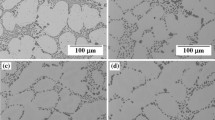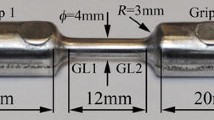Abstract
The contribution of porosity variation affecting the tensile properties of A356 aluminium alloys was investigated in terms of the variations in the quality index of tensile properties as well as the strength coefficient and strain-hardening exponent associated with the T6-treatment. The test specimens were prepared using a low-pressure die-casting and subsequent T6-treatment, and the contribution of microporosity, microstructural features and strain-relating factors to quality index was quantitatively evaluated using a modified constitutive model. The quality index of A356 alloys increases gradually with the lapse of ageing time upon T6-treatment, which increases significantly at the initial ageing stage with rise in the ageing temperature. Additionally, the quality index of A356 alloy primarily depends on the porosity variation with power law relationship, irrespective of its state, i.e. solutionised or artificially aged. Theoretically, the strength coefficient directly determines the nominal level of quality index. The overall dependence of quality index on porosity variation is weakened with increasing tensile strain, but it significantly depends upon the porosity variation for lower values of the strain-hardening exponent. The age hardening arises an explicit transition on fracture path by the damage evolution of eutectic Si particles, which can influence the overall level of quality index through a change in the effective void area fraction, with the microporosity variation by pre-existing micro-voids in casting alloys.
Graphic abstract
A wide deviation on quality index of A356 casting alloy depends practically upon the microporosity variation. Additionally, the nominal level of quality index is influenced by the damage evolution of eutectic Si particles as well as the variation of strength coefficient and strain-hardening exponent by age hardening on T6-treatment. The theoretical approach by constitutive model can quantitatively describe the individual contributions of the strength coefficient and strain-hardening exponent to the overall level of quality index, including the microstructural features such as the area fraction and distribution aspect of micro-voids and eutectic Si particles.














Similar content being viewed by others
References
M. Drouzy, S. Jacob, M. Richard, Interpretation of tensile results by means of quality index and probable yield strength. AFS Int. Cast Met. J. 5, 43–50 (1980)
C.H. Cáceres, Material properties and quality index in Al–Si–Mg casting alloys. AFS Trans. 106, 601–604 (1998)
C.H. Cáceres, A rationale for the quality index of Al–Si–Mg casting alloys. Int. J. Cast Met. Res. 12, 385–391 (2000)
C.H. Cáceres, J.H. Sokolowski, P. Gallo, Effect of aging and Mg content on the quality index of two model Al-Cu-Si-Mg alloys. Mater. Sci. Eng., A 271, 53–61 (1999)
C.H. Cáceres, J. Barresi, Selection of temper and Mg content to optimize the quality index of Al–7Si–Mg casting alloy. Int. J. Cast Met. Res. 12, 377–384 (2000)
C.H. Cáceres, Microstructure design and heat treatment selection for casting alloys using the quality index. J. Mater. Eng. Perform. 9, 215–221 (2000)
C.H. Cáceres, A phenomenological approach to the quality index of Al–Si–Mg casting alloy. Int. J. Cast Met. Res. 12, 367–375 (2000)
G. Sigworth, Understanding quality in aluminum castings. Inter. Metalcast. 5, 7–22 (2011)
M.F. Lbrahim, A.M. Samuel, H.W. Doty, F.M. Samuel, Effect of aging conditions on precipitation hardening in Al–Si–Mg and Al–Si–Cu–Mg alloys. Inter. Metalcast 11, 274–286 (2017)
L. Alyaldin, M.H. Abdelaziz, A.M. Samuel, H.W. Doty, S. Valtierra, F.M. Samuel, Effects of alloying elements and testing temperature on the Q-index of Al–Si based alloys. Inter. Metalcast 12, 839–852 (2018)
M. Tiryakioglu, J. Campbell, Quality index for aluminum alloy castings. Inter. Metalcast 8, 39–42 (2014)
M. Riestra, A. Bjurenstedt, T. Bogdanoff, E. Ghassemali, S. Seifeddine, Complexities in the assessment of melt quality. Inter. Metalcast 12, 441–448 (2018)
T.I. So, W.C. Jung, C.D. Lee, K.S. Shin, Effects of T6-treatment on the defect susceptibility of tensile strength to microporosity variation in low pressure die-cast A356 alloy. Met. Mater. Inter. 21, 842–849 (2015)
C.D. Lee, Effect of artificial ageing on the defect susceptibility of tensile properties to porosity variation in A356 aluminium alloys. Inter. Metalcast 12, 321–330 (2018)
A.K. Ghosh, Tensile instability and necking in materials with strain hardening and strain-rate hardening. Acta Metall. 25, 1413–1424 (1977)
M.K. Surappa, E. Blank, J.C. Jaquet, Effect of macroporosity on the strength and ductility of cast Al–7Si–0.3Mg alloy. Scr. Metall. 20, 1281–1286 (1986)
C.H. Cáceres, B.I. Selling, Casting defects and the tensile properties of an Al–Si–Mg alloy. Mater. Sci. Eng. A 220, 109–116 (1996)
C.D. Lee, K.S. Shin, Constitutive prediction of the defect susceptibility of tensile properties to microporosity variation in A356 aluminum alloy. Mater. Sci. Eng. A 599, 223–232 (2014)
C.D. Lee, K.S. Shin, Y.J. Kim, Dependence of tensile ductility on damage evolution of eutectic Si-particles and pre-existing micro-voids in Al–Si casting alloy. Eng. Mater. Fract. 175, 339–356 (2017)
A.M. Gokhale, G.R. Patel, Quantitative fractographic analysis of variability in tensile ductility of a squeeze cast Al–Si–Mg base alloy. Mater. Charact. 54, 13–20 (2005)
A.M. Gokhale, G.R. Patel, Origins of variability in the fracture-related mechanical properties of a tilt-pour-permanent-mold cast Al-alloy. Scr. Mater. 52, 237–241 (2005)
C.D. Lee, Effect of damage evolution of Si particles on the variability of the tensile ductility of squeeze-cast Al–10%Si–2%Cu–0.4%Mg alloy. Mater. Sci. Eng. A 527, 3144–3150 (2010)
M.D. Dighe, A.M. Gokhale, M.F. Horstemeyer, Effect of loading condition and stress state on damage evolution of silicon particles in an Al–Si–Mg-base cast alloy. Met. Mater. Trans. 33A, 555–565 (2002)
J.R. Rice, D.M. Tracey, On the ductile enlargement of voids in triaxial stress fields. J. Mech. Phys. Solids 17, 201–217 (1969)
A. Weck, D.S. Wilkinson, Experimental investigation of void coalescence in metallic sheets containing laser drilled holds. Acta Mater. 56, 1774–1784 (2008)
P.F. Thomason, Ductile Fracture of Metals (Pergamon, Oxford, 1990)
C.H. Cáceres, T. Din, A.K.M.B. Rashid, J. Campbell, Effect of ageing on the quality index of an Al–Cu alloy. Mater. Sci. Technol 15, 711–716 (1999)
Acknowledgements
This research was supported by the General Researcher Program through the National Research Foundation of Korea (NRF) and funded by the Ministry of Education, Science and Technology (NRF-2017R1D1A1B03028953).
Author information
Authors and Affiliations
Corresponding author
Additional information
Publisher's Note
Springer Nature remains neutral with regard to jurisdictional claims in published maps and institutional affiliations.
Rights and permissions
About this article
Cite this article
Lee, C. Quality Index of Tensile Property on Porosity Variation in A356 Casting Alloys upon T6 Treatment. Met. Mater. Int. 27, 900–913 (2021). https://doi.org/10.1007/s12540-019-00522-w
Received:
Accepted:
Published:
Issue Date:
DOI: https://doi.org/10.1007/s12540-019-00522-w




